Growing Lettuce Organically
Growing lettuce is great to do with kids, because it’s so easy to grow and it grows so quickly. Lettuce goes from seed to baby greens in 5-6 weeks, and seed to salad bowl in 6-8 weeks, so it’s a great plant for school gardens.
|
and ‘Santoro’ Lettuce © Steve Masley (Click IMAGE to Enlarge) |
Lettuce is grown mainly for its leaves, although the stems are used as well in Chinese cooking.
As long as it gets regular water, lettuce can thrive in trays as shallow as 4” (10 cm), and pots of any kind, so it’s a great plant for container vegetable gardening.
Because it grows so quickly, lettuce, like spinach, is an ideal short-season vegetable to interplant between long-season vegetables like peppers, tomatoes, eggplants, and cruciferous vegetables like broccoli or cauliflower.
Looseleaf and butterhead lettuce varieties can be grown in cut- and- come-again beds, where the plants are clipped off an inch from the ground and the stumps regenerate to give you a second cutting a couple weeks later.
Lettuce Varieties
|
Growing Lettuce in Containers
Harvesting Lettuce
|
Salad Tables
|
SaladScapes
How to Grow Lettuce
Like spinach and other spring ephemerals, lettuce forms a low rosette of leaves in early spring, then sends up a flower stalk when summer heat and dryness set in. Lettuce turns bitter once the flower stalk begins to form, so harvest before a central stem starts to form.
|
© Steve MasleyClick IMAGE to Enlarge |
The biggest mistake gardeners make growing lettuce is planting one big patch at the beginning of summer. Five weeks after sowing seeds, they’re swimming in lettuce.
They eat huge salads every day for a week, and still they can’t keep up. Half the crop goes bitter and bolts.
Succession planting is the key to growing lettuce if you want a steady supply of lettuce for salads and sandwiches. From spring through fall, Thomas Jefferson planted a teaspoon of lettuce seeds every Monday at Monticello, so they’d have lettuce all summer long.
For home gardeners, planting a small patch where you have a gap in the garden every 2-3 weeks will give you a steady supply through the summer. Container gardeners or balcony farmers can start new salad trays or planters every few weeks.
Top of Page
|
Lettuce Varieties
|
Soil Preparation
|
Planting
Watering
|
Fertilizing
|
Plant Care
|
Pests
|
Diseases
Companion Plants
|
Lettuce in Containers
|
Salad Tables
|
SaladScapes
Lettuce Cold Tolerance/Season
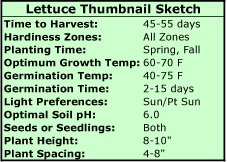
Lettuce is a cool-season vegetable that thrives in the lower temperatures of spring and fall. Seedlings can germinate in temperatures as low as 40° (4° C), but germination gets spotty in temperatures over 75° (24° C). Although it can withstand hard frosts, if the root freezes, the plant thaws into a puddle of green goo.
If you’re growing lettuce in the fall, winter, or early spring, choose upright lettuce varieties, like Buttercrunch and Romaine. They grow up more than out, so they have fewer leaves in contact with the soil when it’s cold, wet, and dark, and fungi are looking for a meal.
Because of their upright habit, leaves aren’t in contact with the soil, where diseases spread easily in cold weather, and only the tips of their leaves—not the soft parts—are exposed to the cold of open sky at night.
|
© Steve Masley (Click IMAGE to Enlarge) |
If you’re growing lettuce in the summer, in all but the most northern climates, shield it from the mid-day sun. Try growing lettuce in the shade of taller plants, and make sure it gets plenty of water. Romaine or Batavian lettuces are more heat-tolerant than other lettuce varieties.
A mobile Salad Table allows you to move lettuces to full shade in hot weather.
Top of Page
|
Lettuce Varieties
|
Soil Preparation
|
Planting
Watering
|
Fertilizing
|
Plant Care
|
Pests
|
Diseases
Companion Plants
|
Lettuce in Containers
|
Salad Tables
|
SaladScapes
Garden Preparation for Growing Lettuce
Growing lettuce is easy in any good garden soil. Incorporate 2-3” (5-8 cm) of garden compost or composted manure in the bed at planting time.
If you’re not using manure, for really luxurious growth you can add an organic nitrogen source at the time of planting. In cold weather, choose a fast-release organic nitrogen fertilizer like worm castings, composted chicken manure, bat guano, blood meal, or fish meal.
In warmer weather, slower-release, vegetable-based organic soil amendments like alfalfa or soy meal will supply the nitrogen needed for growing lettuce.
Lettuce, spinach, and most green, leafy vegetables benefit from supplemental calcium, especially in sandy soils. Adding ground oyster shells or dried, crushed eggshells (1 lb/100 square feet, 0.5kg/9 square meters) adds calcium, and a dusting of kelp meal (1 lb/100 square feet, 0.5kg/9 square meters) will boost plant immunity and help prevent disease problems.
Top of Page
|
Lettuce Varieties
|
Soil Preparation
|
Planting
Watering
|
Fertilizing
|
Plant Care
|
Pests
|
Diseases
Companion Plants
|
Lettuce in Containers
|
Salad Tables
|
SaladScapes
Planting Lettuce
Lettuce can be direct sown in prepared beds after the last frost date for your area, but planting seedlings produces salads more quickly. Lettuce seedlings also have greater frost tolerance than seedlings that have just germinated.
In short-summer gardens, do both. Set out seedlings as an between main crop plants, and start a seedbed somewhere else in the garden at the same time.
The lettuce in the seedbed will start coming in just as you’re finishing up the lettuce started from seedlings.
Lettuce Seed Depth and Plant Spacing
Plant spacing for growing lettuce depends on the variety, and whether you’re growing lettuce for baby greens, or mature leaves or heads.
For baby greens, sow lettuce seeds in 4” (10 cm) bands, about 60 seeds/foot (200 seeds/meter). Scatter the seeds over the surface, then cover with a thin (1/8” (2-3 mm) layer of fine mulch. Water thoroughly and keep the seedbed moist until germination.
Harvest when the plants are 2-3” (5-8 cm) high by snipping the plants off 1” (2.5 cm) above ground with a pair of scissors. Pull up and compost the roots, or add them to a worm composting system—worms love the fine roots of lettuce plants.
For cut-and-come-again lettuce beds, plant seedlings on 4” (10 cm) centers (4” or 10 cm apart in each direction), or sow seeds and thin to this spacing. When the plants are 4-6” (10-15 cm) high, harvest as needed by cutting them off 1” (2.5 cm) from the ground with a pair of scissors, and water the stumps.
Continue cutting plants as needed, clearing a swath from one side of the bed to the other. By the time you reach the end of the bed, the first plants harvested will have regenerated, and you’ll get a second cutting.
If you’re growing lettuce to maturity in a single-dug bed (soil prepared to 1 shovel depth), plant in rows 12” (30 cm) apart, and set plants out (or thin seedlings) to 6-8” (15-20 cm) apart. Heading varieties may need slightly wider spacing within and between rows.
If you’re growing lettuce as an interplant in a deep-dug bed, set plants on 6-8” (15-20 cm) centers between main-crop plants.
Top of Page
|
Lettuce Varieties
|
Soil Preparation
|
Planting
Watering
|
Fertilizing
|
Plant Care
|
Pests
|
Diseases
Companion Plants
|
Lettuce in Containers
|
Salad Tables
|
SaladScapes
Care and Feeding of Lettuce
Watering
Lettuce, like all fall vegetables, requires regular water to maintain the succulent growth that keeps plants from bolting. In hot weather, they’ll need water every day, and if you’re growing lettuce in containers, they may need water twice a day.
Lettuce needs 1-1 ½” (2.5-3.8 cm) of water per week. Plan to irrigate if you don’t get enough rainfall. Lettuce that doesn’t get enough water turns bitter and bolts.
Fertilizing
If you build organic soil amendments into the soil at planting time, no subsequent fertilizing is necessary for growing lettuce.
Lettuce Plant Care
Apart from watering and keeping up with the harvest, growing lettuce takes little work.
Lettuce Pests
Birds, rabbits, and ground squirrels can do a number on a lettuce patch, especially young seedlings. Damage from birds can be eliminated with bird net or floating row covers. Rabbits and rodents will just chew through bird net to get to your lettuces, but floating row covers hide the plants from view and can reduce damage.

|

|
|
|
Lettuce Loopers are green caterpillars 1/2-3/4” (12-19 mm) long that look like inchworms. The adults are a nondescript brown moths that you’re unlikely to ever see, but you’ll know the larvae are present when you see a lot of leaf damage, and green caterpillar poop.
| Garlic-Oil Soap Spray |
|---|
|
Soap-and-Oil Sprays are part of the organic garden pest control toolkit. Insects breathe through pores in the sides of their exoskeletons. Soap surfactants cover these pores, suffocating the insects. The oil helps the soap spray stick to the insect. Partially fill a quart hand-pump sprayer (one that’s never been used for chemicals) with warm water. Add 1 tsp vegetable oil and 3-4 drops of dish soap. Shake and mix thoroughly, then spray plants, making sure you cover the undersides of leaves. Garlic Oil added to the mix kills insects more quickly, and also kills insect eggs. The garlic has a residual repellant effect that lasts for several days. To make garlic oil, smash several cloves with the blade of a knife, chop coarsely, and allow them to sit for 10 minutes in the bottom of a clean, dry jar (this allows alliinin to reach maximum levels). Cover with vegetable oil and seal the jar. Leave on a counter for 3-4 days, shaking the jar occasionally, then pour the oil through a strainer into a brown glass bottle. Use the same amount of garlic oil as you would vegetable oil. Store garlic oil in a cool, dark place, and it will last 2-3 months. |
Aphids can be a problem when growing lettuce, especially in crowded plantings. They rarely hurt the plants, but aphid infestations make it harder to clean the lettuce when you harvest it. A soap-and-oil spray will knock the population back.
Snails and slugs love lettuce, as much for a cool, moist place to live as something to eat. Keep grasses and weeds down near beds to deny them habitat, and set out boards, propped up an inch on one side with a stick.
Snails and slugs seek shelter under boards in cold, dry weather. Lift the boards and smash them, or, if you have chickens, turn the board over near them, and there won’t be a single snail or slug left alive after a minute.
Top of Page
|
Lettuce Varieties
|
Soil Preparation
|
Planting
Watering
|
Fertilizing
|
Plant Care
|
Pests
|
Diseases
Companion Plants
|
Lettuce in Containers
|
Salad Tables
|
SaladScapes
Lettuce Diseases
Lettuce suffers from a number of diseases and problems that are rarely seen in small-scale, organic production.
Lettuce mosaic virus, downey mildew, corky root, botrytis (grey molds), sclerotinia, and tipburn are some of the diseases or conditions you may see, especially in crowded plantings under adverse conditions.
Overcrowded, stressed plants are more vulnerable to diseases, so proper plant spacing and adequate water can reduce disease problems.
Consult your local agricultural extension office to find out which lettuce diseases are endemic to your area, and plant resistant varieties. Click the links below for Cornell University’s list of disease-resistant red looseleaf, green looseleaf, and butterhead lettuce varieties. (Links open in new windows).
Kelp Meal added to the soil at planting time can boost plant immunity and help prevent lettuce diseases.
Other Lettuce Issues
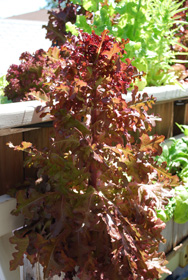
|
|
(Click IMAGE to Enlarge) |
Bolting is the big issue when growing lettuce.
All lettuce plants will eventually bolt, or send up a flower stalk—especially in hot, dry weather, or when they’re not getting enough water.
Lettuces turn bitter before they bolt, and the plants strip resources from the leaves—the part of the plant you eat—to form stalks, flowers, and seeds. If you’re growing lettuce as an interplant between peppers, eggplants, or tomatoes, once it starts bolting, its roots go deeper and it starts competing with late-season vegetables, so take it out.
To reduce bolting, choose appropriate lettuce varieties that can handle the heat expected when they’re planted, mulch around plants to keep the soil cooler and hold in moisture, and make sure plants get plenty of water. Plant in your coolest microclimate or in the shade of taller plants.
If tipburn is a problem, add ground oyster shell or dried, ground eggshells for supplemental calcium.
Top of Page
|
Lettuce Varieties
|
Soil Preparation
|
Planting
Watering
|
Fertilizing
|
Plant Care
|
Pests
|
Diseases
Companion Plants
|
Lettuce in Containers
|
Salad Tables
|
SaladScapes
Companion Plants for Growing Lettuce
Aromatic herbs (like thyme, oregano, or basil) planted around lettuce patches can help mask the plants from pests like lettuce loopers. If aphids are a problem, nasturtiums around the perimeter of the bed can act as a trap crop to draw aphids away from your lettuce plants.
|
© Steve Masley…Click IMAGE to Enlarge |
In a raised garden bed, lettuce is an ideal interplant for tomatoes, peppers, and long-season brassicas like broccoli, cabbage, and cauliflower.
Plant the main crop plants on the spacing the plants will need at maturity—usually 18-24” (46-61 cm)—then interplant lettuce on 6” (15 cm) centers to fill the bed space between the main-crop plants.
The lettuce protects the soil from the drying effects of sun and wind or compaction by driving rain, and it shades out weeds while the main crop plants are getting established. The low canopy also holds in carbon dioxide off-gassed from the soil, which can improve growth of late-season plants.
By the time the lettuce is ready to harvest, the main crop plants will be ready to take over the space.
Top of Page
|
Lettuce Varieties
|
Soil Preparation
|
Planting
Watering
|
Fertilizing
|
Plant Care
|
Pests
|
Diseases
Companion Plants
|
Lettuce in Containers
|
Salad Tables
|
SaladScapes
Growing Lettuce in Containers
|
© Steve Masley (Click IMAGE to Enlarge) |
Lettuce is one of the best vegetables for growing in containers. Lettuce roots monopolize the top few inches of soil to form their leaves. As long as it gets regular water, lettuce can thrive in salad trays as shallow as 4” (10 cm).
Grandmothers who used to grow lettuce in old dresser drawers knew this.
See Salad Tables for more information on growing lettuce in shallow trays. SaladScapes takes growing lettuce to an art form.
If you’re growing lettuce in pots or window boxes, use a good organic potting mix, or make your own. It’s usually best to plant seedlings, instead of seeds, unless you can be ruthless about thinning.
Click any image below to see a larger version:
When growing lettuce in containers or window boxes, set the plants out on 4-6” (10-15 cm) centers, or thin plants to this spacing.
Crowded plants are prone to problems in vegetable beds, and the problems only get worse in containers.
Frequent watering is the key to growing lettuce in containers, especially if you grow them in salad trays or other shallow containers. As long as they get enough water, lettuces growing in pots are fine in full sun during spring and fall.
In summer, move the containers to full or partial shade to delay bolting.
Click any image below to see a larger version:
Top of Page
|
Lettuce Varieties
|
Soil Preparation
|
Planting
Watering
|
Fertilizing
|
Plant Care
|
Pests
|
Diseases
Companion Plants
|
Lettuce in Containers
|
Salad Tables
|
SaladScapes
Harvesting Lettuce
|
Frizzy Headed’ Lettuces © Steve Masley Click IMAGE to Enlarge |
The biggest mistake people make when harvesting lettuce is waiting too long to harvest. Once a flower stalk begins to form, most lettuce varieties are already too bitter to eat. Then, it’s only good for stir-fries or saving seeds.
Early morning is the best time for harvesting lettuce. The leaves have plumped up overnight, and are at their most succulent.
Avoid harvesting in the blazing sun and heat of the afternoon. Evening harvesting works if you water first and wait 15 minutes.
Gather the leaves in one hand, and cut them off from the base of the plant with a pair of scissors or a knife.
|
Click IMAGE to Enlarge |
Cut about an inch (2.5 cm) from the ground. If they get enough water, looseleaf, butterhead, and romaine lettuces will resprout from the base, giving you a second cutting a couple weeks after the first.
It’s best to process lettuce soon after harvesting. Swish the leaves around in a large bowl of water. If there are any aphids on the leaves, they’ll either float to the surface or sink to the bottom. When you run more water into the bowl, the aphids on the surface float away with the overflow from the bowl.
Spin the lettuce in a salad spinner, and store it in bags in the vegetable drawer in the fridge. If you put a half-strip of paper towel in the bag and suck the air out before tying it, the lettuce will stay salad-fresh for two weeks in the crisper.
I’ve pulled lettuce stored this way out of the refrigerator after 3 weeks, expecting it to be blue-and-gooey, and it’s still superior to anything you’d find in a supermarket.
What to do with lettuce that’s bolted. If you catch it soon after a flower stalk starts rising, before a lot of flowers set, the stalks are still succulent, and are good in stir-fries. Their bitterness is masked by other ingredients, and actually contributes to the flavor of the dish.
Once a lot of flowers set, the stems get tougher and more fibrous, and the bitterness only increases. At this point, you can let them flower and save seeds for varieties you like, or just compost them.
Top of Page
|
Lettuce Varieties
|
Soil Preparation
|
Planting
Watering
|
Fertilizing
|
Plant Care
|
Pests
|
Diseases
Companion Plants
|
Lettuce in Containers
|
Salad Tables
|
SaladScapes
Lettuce Varieties
|
Salad Tables
|
SaladScapes
How To Grow Vegetables
|
Growing Vegetables in Containers
Copyright © 2009-2025, by Steve Masley, Grow-it-Organically.com
All rights reserved
HOME | About Us | Contact Us | Privacy
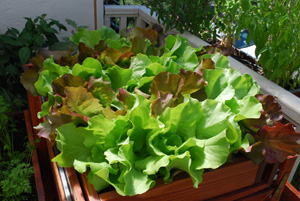

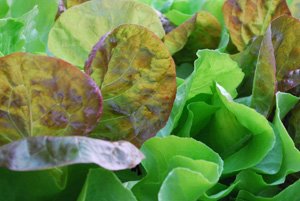
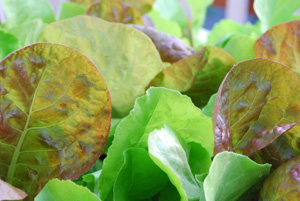
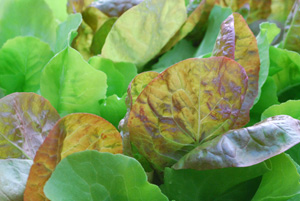
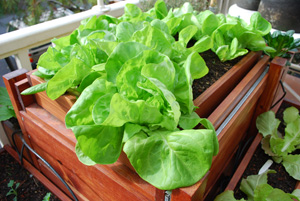
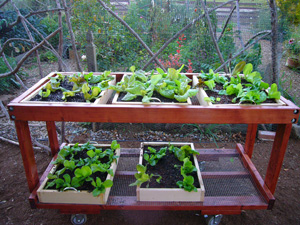
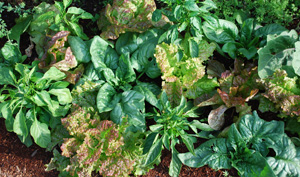
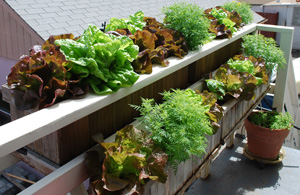
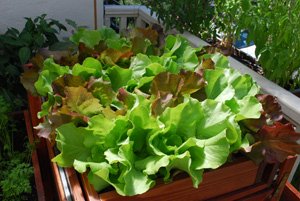
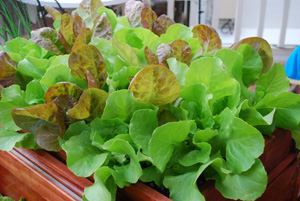
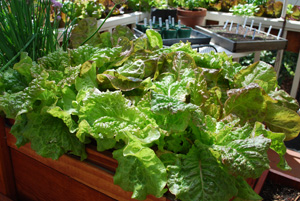
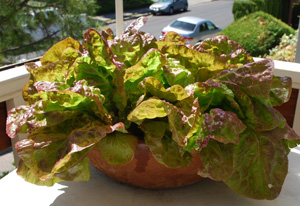
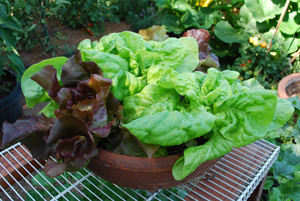
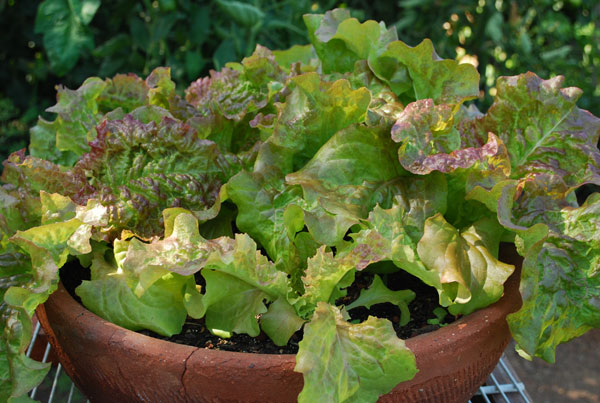
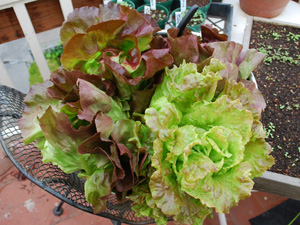
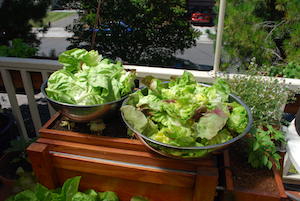
New! Comments
Have a question or comment about what you just read? Leave me a comment in the box below.